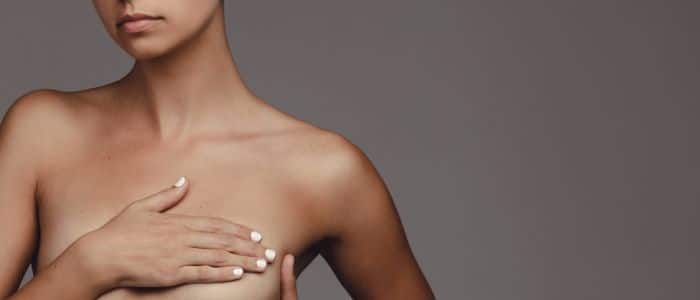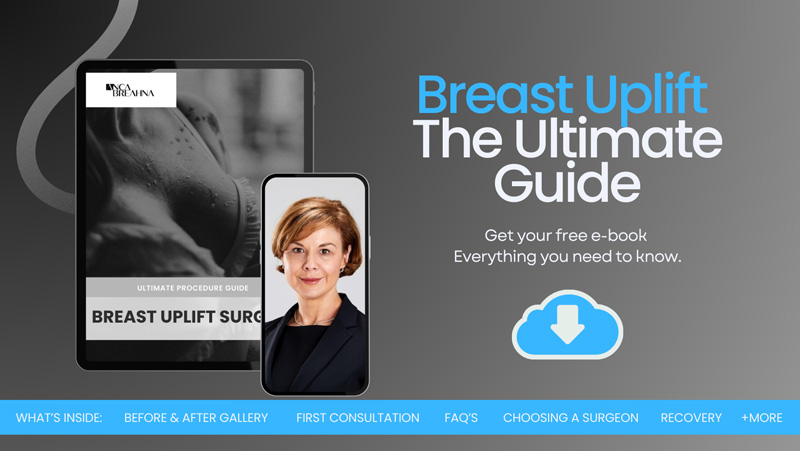
Treatment Options for Inverted Nipples
Inverted nipples, a condition where the nipples retract into the breast rather than protruding outward, are a common concern for many women. Whether you’re exploring non-surgical methods or considering surgical intervention, in this blog, Chester Consultant Plastic Surgeon Anca Breahna will walk you through each step of the journey towards nipple correction, offering insights and advice to help you make informed decisions.
What Are Inverted Nipples?
Inverted nipples, characterised by the inward turning of the nipple, can be classified into three grades based on severity. Grade 1 involves nipples that can easily be pulled out and may occasionally protrude on their own. Grade 2 nipples are more difficult to draw out and do not maintain their protrusion. Grade 3 nipples are fully inverted and cannot be pulled out manually. This condition is not uncommon and can affect one or both nipples.
The causes of inverted nipples can be divided into congenital and acquired. Some individuals are born with this condition due to the way their breast tissue developed. Others may develop inverted nipples as a result of underlying health issues, such as infections or changes in breast tissue over time.
Take our Plastic Surgery Quiz to find out if you’d be a good candidate for cosmetic surgery.
What Causes Inverted Nipples?
Inverted nipples can be caused by several factors, which can be broadly categorised into congenital (present from birth) and acquired (develop over time):
Congenital Causes
- Natural Variation in Breast Development: In many cases, inverted nipples are simply a variation in the way the breast and nipple area develop. Some women are born with nipples that do not protrude as is typically expected but instead retract inward. This can affect one or both nipples.
- Tightened or Shortened Breast Ducts: The ducts beneath the nipple can be naturally shorter or tighter in some women, which pulls the nipple inward. Since these ducts are essentially the structures that connect the underlying breast tissues to the nipple, their length and flexibility can significantly influence nipple protrusion.
Acquired Causes
- Changes in Breast Tissue: Significant changes in breast tissue due to ageing, weight fluctuations, or hormonal shifts can lead to nipple inversion. As the breast tissue changes, it can affect the tension and relationship between the nipple and the surrounding tissues.
- Breastfeeding: The process of breastfeeding, especially if it involves complications like mastitis (an infection of the breast tissue), can sometimes lead to nipple inversion. The repeated stress on the nipple and potential scarring from infections can cause the nipple to retract inward.
- Trauma or Surgery: Any trauma, surgical intervention, or radiation treatment to the breast area can result in scar tissue formation. This scar tissue can contract over time, pulling the nipple inward.
- Underlying Health Conditions: Certain medical conditions, such as breast cancer or infections, can lead to nipple inversion. In these cases, the inversion might be a symptom of the underlying condition affecting the breast tissue’s structure and health.
When to Seek Help for Inverted Nipples
Recognising inverted nipples usually involves observing the characteristics of the nipples and how they respond to stimulation or temperature changes. It’s important to consult Anca for a proper diagnosis to rule out underlying conditions that may cause or contribute to nipple inversion.
Seeking medical advice is especially recommended if the inversion of the nipples is a new development or if it’s accompanied by other symptoms such as discharge, pain, or changes in the breast skin. These signs could indicate more serious health issues that require immediate attention.
Non-Surgical Solutions for Inverted Nipples
Non-surgical solutions for inverted nipples offer a less invasive approach for those seeking correction. These options, ranging from simple home exercises to the use of specialised devices, can provide significant improvements without the need for surgery.
Home Remedies and Exercises
Home remedies and exercises aim to encourage the nipple to protrude by strengthening the surrounding tissue and increasing nipple flexibility. One common technique involves gently pinching the area around the nipple to promote protrusion. Additionally, exercises that focus on breast massage can help by stimulating the nipple area and potentially encouraging it to extend outward. It’s important to approach these methods with patience and consistency, as results may vary and take time to manifest.
Devices and Accessories
Several devices and accessories have been designed specifically to assist with nipple inversion. Nipple suckers and everters, for example, use gentle suction to draw the nipple outwards. These devices can be particularly helpful for women with Grade 1 or Grade 2 inverted nipples. It’s advisable to use these products under the guidance of your surgeon to ensure they are applied correctly and to avoid potential harm.
Download the Breast Uplift Guide

Can Piercing My Nipples Help Correct Inversion?
Nipple piercing is sometimes considered by people with inverted nipples as a method to encourage the nipples to maintain a protruded position. The idea is that the jewellery (usually a barbell) can act as a physical barrier, preventing the nipple from retracting back into the breast tissue. While piercing can offer a cosmetic solution for some, there are several factors and potential outcomes to consider:
Potential Benefits
- Temporary Correction: For women with Grade 1 (mild) inversion, where the nipple can be easily pulled out, piercing may help the nipple to stay in an everted position more consistently.
- Aesthetic Appeal: Aside from addressing inversion, nipple piercings are also a form of body modification that some individuals find aesthetically pleasing or empowering.
Considerations and Risks
- Not a Permanent Solution: Piercing might not provide a long-term correction for inverted nipples, especially for more severe cases (Grade 2 and Grade 3). The effectiveness largely depends on the individual’s anatomy and the degree of inversion.
- Risk of Infection: Any piercing comes with a risk of infection, which can be higher in areas like the nipples. Proper aftercare is essential to minimise this risk.
- Pain and Healing Time: Nipple piercing can be painful, and the healing process can be lengthy and complicated, with a higher chance of issues like rejection or migration of the jewellery.
- Impact on Breastfeeding: There’s a potential impact on breastfeeding capability, as the piercing could cause blockages in the milk ducts or lead to other complications. Though many people with nipple piercings can breastfeed successfully, it’s a consideration for those planning to breastfeed in the future.
- Allergic Reactions: There’s also a risk of allergic reactions to the jewellery material, which can complicate the healing process.
Surgical Options for Inverted Nipples
The journey towards correcting inverted nipples through surgical means involves several potential procedures, each tailored to the specific needs and conditions of the patient:
Nipple Eversion Surgery
Nipple eversion surgery stands as a prominent option for those seeking a permanent solution to inverted nipples. This procedure is designed with the aim of repositioning the nipple to an outward, natural-looking state. The technique involves making small incisions at the base of the nipple, through which Anca carefully releases the shortened ducts and fibrous bands responsible for pulling the nipple inward. Once these structures are released, the nipple can be brought out to a protruding position.
Anca may employ sutures beneath the nipple to maintain its outward position during the healing process. These sutures are usually placed in a way that they anchor the nipple in its new position, allowing the tissues to heal and adapt. The goal is to achieve a permanent correction, with the nipple maintaining its protrusion long after the surgery.
The success of nipple eversion surgery largely depends on the grade of nipple inversion and your specific anatomy. For some, this procedure offers a straightforward solution with satisfying results. However, it’s important to note that while the surgery aims to preserve the ducts, in some cases, it might affect breastfeeding capability. Discussing these potential outcomes with Anca is a part of the pre-surgery consultation.
Other Surgical Interventions
In some cases, addressing inverted nipples may be part of a larger breast surgery, such as augmentation, reduction, or lift. These procedures provide an opportunity to correct nipple inversion in conjunction with other modifications to the breast’s shape or size. For example, during a breast lift, Anca can adjust the position of the nipple and areola, including correcting any inversion.
Choosing the right surgical intervention requires a complete evaluation by a skilled plastic surgeon, who can assess the degree of nipple inversion, discuss desired outcomes, and recommend the most appropriate procedure based on your unique anatomy and health considerations. The ultimate goal is to achieve a result that not only corrects the inversion but also aligns with your aesthetic preferences and lifestyle needs.
Each of these surgical options comes with its own set of considerations, including recovery time, potential risks, and impact on future breastfeeding. Open and honest discussions with Anca are essential to navigating these choices and moving forward with confidence in your decision to pursue surgical correction for inverted nipples.
FAQs about Inverted Nipples
Can wearing tight clothes cause nipples to become inverted?
- No, wearing tight clothes does not cause nipples to become inverted. Inversion is typically due to the structure and development of the breast tissue and ligaments beneath the skin and is not influenced by external compression from clothing.
Is it possible for inverted nipples to correct themselves over time?
- In some cases, especially with Grade 1 inverted nipples, there might be natural changes due to hormonal shifts, such as during pregnancy or puberty that could lead to the nipples becoming everted temporarily or permanently. However, this is not guaranteed, and changes in nipple protrusion can vary greatly among individuals.
Do inverted nipples affect the ability to detect breast lumps or other abnormalities?
- Inverted nipples themselves do not hinder the ability to detect breast lumps or abnormalities. Regular breast self-examinations can and should be performed by all individuals, regardless of nipple type, to check for any unusual changes in the breast tissue.
Can men have inverted nipples?
- Yes, men can also have inverted nipples. The condition is not exclusive to women and can affect anyone, regardless of gender. The causes and potential treatments for inverted nipples are similar for both men and women.
Are there any specific sports or physical activities that are recommended or should be avoided with inverted nipples?
- There are no specific sports or physical activities that individuals with inverted nipples need to avoid or specifically engage in. Inverted nipples do not generally affect physical capabilities or the health of the breast tissue. It’s always important, however, to wear appropriate and supportive attire for comfort and breast health during exercise.
Further Reading about Breast Surgery with Consultant Plastic Surgeon Anca Breahna
- Read more about How to Choose the Best Breast Implant Profile and Projection
- Read more about How to Fix Saggy Breasts – Breast Uplift, Breast Implants or Both
- Read more about What is Breast Augmentation Surgery?
- Read more about All about Perfect Breasts and How to Get Them
- Read more about What Are Pointy Breasts or Puffy Nipples?
Medical References about Inverted Nipples
- Inverted (Retracted) Nipples: Signs, Causes & Treatment – Cleveland Clinic
- Inverted Nipples: Common Causes – WebMD
- Inverted Nipple: Treatment, Causes, And Pictures – Medical News Today
- Surgical Correction of Inverted Nipples – NCBI
- Nipple Enhancement for Inverted Nipples – Australian Society of Plastic Surgeon



 Ms Anca Breahna, PhD, MSc, FEBOPRAS, FRCS (Plast) is a highly regarded Consultant Plastic Surgeon specialising in the field of Aesthetic and Reconstructive Plastic Surgery. Anca performs a range of
Ms Anca Breahna, PhD, MSc, FEBOPRAS, FRCS (Plast) is a highly regarded Consultant Plastic Surgeon specialising in the field of Aesthetic and Reconstructive Plastic Surgery. Anca performs a range of 